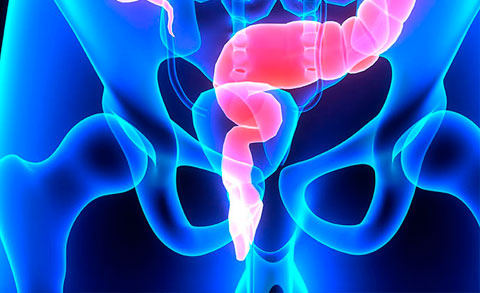Cancer of the anus
Causes and prevention
 An increased risk of cancer of the anus is associated with infection with the human papillomavirus (HPV), the number of sexual partners during life, the presence of sexually transmitted infections, smoking, anal intercourse, infection with the human immunodeficiency virus (HIV), chronic immunosuppression (for example, after organ transplantation). With age the risk of developing cancer of the anal canal, like most oncological diseases, increases.
An increased risk of cancer of the anus is associated with infection with the human papillomavirus (HPV), the number of sexual partners during life, the presence of sexually transmitted infections, smoking, anal intercourse, infection with the human immunodeficiency virus (HIV), chronic immunosuppression (for example, after organ transplantation). With age the risk of developing cancer of the anal canal, like most oncological diseases, increases.
Women who have abnormal cervical or vulvar cells or have been diagnosed with cervical or vulvar cancer have a higher risk of developing anal cancer. If we talk about etiological factors, anal cancer is closer to genital malignant diseases than to tumors of the gastrointestinal tract.
The prevention of risk factors can be considered as measures to prevent cancer of the anus: reducing the risk of HIV and HPV infection, quitting smoking, and undergoing regular checkups.
Types of anal cancer
-
Squamous cell carcinoma. Almost all types of anal cancer (9 out of 10 or 90%) develop from the squamous epithelium lining the anal canal and the edge of the anus.
-
Adenocarcinoma. Some types of anal cancer develop from glandular cells. Such cancers are called adenocarcinomas. They account for less than 5% of anal cancers. Adenocarcinomas develop similarly to rectal cancer and have similar treatment tactics.
-
Sarcoma. This type of anal canal tumor is extremely rare.
-
Tumors of the perianal skin. This group includes such oncological diseases as basal cell carcinoma, melanoma, Bowen's disease, and Paget's extra-mammary disease.
Symptoms of anal cancer
This disease is not characterized by an early pronounced manifestation of the clinical picture. The most common symptoms of anal cancer:
-
bleeding from anus
-
pain, discomfort and itching around the anus
-
small swellings around the anus; they are often mistaken for hemorrhoids, which can hinder timely diagnosis
-
ulceration around the anus
About 1 out of 5 cases of anal cancer (20%) are not accompanied by any manifestations. If symptoms persist for several weeks or progress, it is important to refer the patient to an oncologist in a timely manner.
Diagnostics
If anal cancer is suspected, a physical examination, palpation of the groin area, and a biopsy of the primary tumor are mandatory. Staging also includes CT of the chest organs, CT or MRI of the abdominal cavity and pelvis, PET/CT. Women should undergo a gynecological examination, including screening for cervical cancer. Surgical staging is currently not carried out routinely.
Treatment
The main treatment for cancer of the anus is a combination of radiation therapy and chemotherapy, carried out simultaneously. Chemoradiotherapy is usually highly effective for the treatment of anal cancer, so most patients do not need surgical treatment.
Surgery for cancer of the anus may be required in the following cases:
-
in case of incomplete tumor removal after chemoradiotherapy;
-
for anal cancer in the early stages, when the tumor size does not exceed 2 cm, and it can be removed using only a surgical method;
-
in some cases, surgery may be required to relieve symptoms before chemoradiotherapy;
-
in case of tumor recurrence after treatment.
Radiation therapy is sometimes used as the only treatment method if the patient's condition does not allow chemoradiotherapy. Chemotherapy can also be used on its own for advanced cancer.
How is chemoradiotherapy performed for anal cancer
At the EMC Institute of Oncology , radiation therapy is performed using the latest generation of linear accelerators that allow precision, i.e., super-precise radiation treatment without damaging surrounding healthy tissues.
Chemoradiotherapy is usually performed on an outpatient basis. The basic treatment plan consists of 4-6 weeks of radiation therapy and two cycles of chemotherapy. 5-fluorouracil, mitomycin and cisplatin are commonly used as chemotherapy drugs.
Chemotherapy drugs are injected into a vein (intravenously). Some patients receive fluorouracil through a portable chemotherapeutic pump that is taken home. In some cases, instead of fluorouracil, the drug capecitabine is prescribed, which is taken orally in tablets.
Surgical treatment
With a small tumor located outside the anal margin, surgery may be the main treatment method. This is only possible if the surgeon can remove the formation without affecting bowel function.
When else can surgical treatment be used?:
-
after chemoradiotherapy with incomplete tumor removal
-
with signs of tumor recurrence
-
if it is impossible to receive radiation therapy, for example, if it has already been performed on the pelvic organs
-
to eliminate intestinal blockage before treatment with chemoradiotherapy
-
if a woman who wants to have children in the future is undergoing treatment
Types of surgical intervention
Local excision
This operation allows you to remove the area of the anus containing cancer cells. It is sometimes used to treat small tumors in the early stages in the anal region. After surgery, there are usually no permanent problems with bowel function control, since the anal sphincter is not affected.
Abdominal-perineal resection (APR)
This is an extensive operation to remove the anus, rectum, and part of the large intestine. Doctors most often recommend APR if the tumor has not completely gone away after chemoradiotherapy or if the disease has recurred. Since APR involves the removal of the anus and rectum, a permanent colostomy is formed in this case.
Historically, both staging and treatment of anal cancer were performed surgically and consisted of abdominal-perineal resection and dissection of inguinal lymph nodes. However, combined chemoradiotherapy has proven to be the preferred treatment method, with the use of radiation therapy in the area of primary damage and spread through the lymph nodes and preventive effects on clinically negative inguinal lymph nodes. This strategy has significantly reduced the incidence of locally advanced relapse.
Follow-up after treatment
Recommendations for monitoring patients with complete remission after primary chemoradiotherapy NCCN offer the following:
-
finger rectal examination
-
anoscopy
-
palpation of inguinal lymph nodes
-
annual imaging of the chest / abdominal cavity and pelvis for three years in cases where treatment is carried out at stages T3-4 or with positive inguinal lymph nodes, as well as in patients with advanced disease during primary biopsy after treatment. which deteriorates over several observations.
For patients undergoing APR with progressive or recurrent disease, inguinal lymph node palpation is performed every 3-6 months for five years, as well as annual chest/abdominal/pelvic imaging using X-ray methods for three years.
The EMC Institute of Oncology is one of the leading oncological institutions in Moscow that treats cancer of the gastrointestinal tract of any complexity. The treatment is carried out by highly qualified oncologists and surgeons from the USA. Israel, Western Europe, and leading Russian experts. After the diagnosis, an oncological consultation is appointed with the participation of an oncologist, surgeon, radiotherapist, who, taking into account the type of tumor and the patient's condition. Chemoradiotherapy is performed according to European and American protocols.
Why the EMC
The first and only clinic in Russia, created in the image of the world's leading clinics
EMC is a multidisciplinary center offering patients a high level of medical services and a personalized approach
Worldwide recognition and awards
 Learn more
Learn more
Worldwide recognition and awards
 Certificates and licenses
Certificates and licenses
Make an appointment for a consultation
Specify your contacts and we will contact you to clarify the details
Reviews
and new products of the EMC



.webp)
















